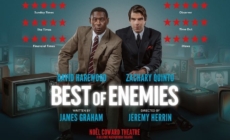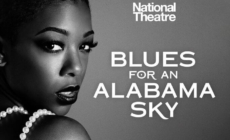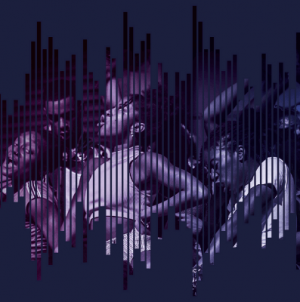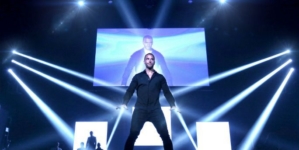-
Botis Seva’s BLKDOG - 09/20/2022
-
BEST OF ENEMIES - 09/20/2022
-
BLUES FOR AN ALABAMA SKY - 09/20/2022
-
Botis Seva’s BLKDOG - 09/09/2022
-
Botis Seva’s BLKDOG - 09/09/2022
-
Big Girl Words - 04/08/2022
-
Things I Can Laugh About Now - 04/08/2022
-
Run It Back - 08/18/2021
-
Belgrade Theatre Vacancy: Chief Executive Officer - 07/28/2021
-
CONSTELLATIONS - 06/15/2021
WASHBURN’S WORLDS: STAGING THE “STRANGE”
Stage directions can be a blessing and a curse for a director, and they exist along a spectrum. At one end you have Shaw, Chekhov, O’Neill who insist upon – across multiple pages and in immense detail – every doorframe, window pane and carpet shape for the world of their play. As well as this, character lines of dialogue are prefaced with precise and prescriptive delivery instructions like (with disdain), (smilingly) or (without any emotion) etc. It can sometimes be a relief to have so much guidance and, depending on the level of reverence in the production, a company could easily be led through each moment of the play. However, this can also feel very paint-by-numbers, with little space for interpretation. At the other end of the spectrum we have writers like Caryl Churchill or Nick Payne whose plays are largely devoid of instruction. The experience of meeting these plays, as director and actor, is both thrilling and terrifying. In Churchill’s Love and Information not only is there is no indication of where the scenes take place, but Churchill also refuses to delineate who says what line. A scene could take place between two people, or 10: the options are infinite.
Anne Washburn exists somewhere in the middle of this spectrum but also entirely in her own category. Her stage directions sound like another character joining the party. They hold humour, conversation, personality and questions:
Intermission. Late Stage Capitalism. Sell things!
DESIGN and STAGING
The scenes should not be staged realistically
During the first read-through of Shipwreck, the stage directions caused ripples of delight through the company, reflecting perhaps a relief that the world of the play revelled in theatricality and wasn’t strict about how that was manifested. At the same time there was intrigue and alarm from the actors as they took a deep breath to begin reading an epic five-act play and met this opening bidding:
sitting, the act of sitting for whatever reason,
should be delayed as long as possible.
In response to Anne’s note, Rupert Goold (the director) and Miriam Buether (the designer) have created a design where sitting only happens when fatigue and necessity sets in – for characters and actors alike. The set is a wide, circular, wooden platform which perfectly embodies a theme that features across Washburn’s work: lost souls who come together and collectively work their way through problems, trying to find an answer to the crisis of their world. The wooden platform might be a raft, a farmhouse living room, a Senate floor, a cave. The sparse design pushes the focus onto the words, the ideas, the people in the room. None of the usual crutches like chairs, tables, realism exist. So how do you stage multiple scenes in varying locations across time jumps with up to eight actors without any of the usual staging devices?
Rupert jumped right in. The actors were all up on the platform together from the second week, wandering like stranded survivors on a desert island. And for the first few days “no sitting” meant they inevitably blocked each other, upstaged themselves and others, felt exposed and were unsure where to direct their text, which positions were high status and low status. But just like the characters in Anne’s plays who try, fail and try again to find a way through their predicament, our company started to learn the space and its gifts. They began to balance each other, making sure the raft never tipped too far one way or another. They experimented and improvised, they broke out of the space and took chances, and overall they started to embrace and enjoy the intimacy and immediacy of what a stripped-back set can bring. Without distractions their characters became more rich, more detailed. Instead of relying on furniture they began to rely on space, angles, energy. A simple movement of a body through space becomes very powerful when we take away the traditional trappings. The actors supported each other with their positioning, being lenses for whoever was speaking, aiding the direction of focus when it was needed. They became playful, lighthearted and utterly transformed. In some moments the staging feels almost film-like in how we focus down on one point or another. The actors move between close-ups, landscapes, mid-frame and sometimes revolving continuous shots.
ACTORS and CHARACTERS
Anne’s instructions to actors are colourful, rich and virtually impossible to play in just a few words of dialogue. E.g
(Ever so slightly intangibly appalled.)
or
(Lightly but not lightly.)
or
(It’s not important but for some reason I feel he might be lying about this.)
But Anne’s particular combination of words always seem to brilliantly convey just the right meaning for how the line should be played and why. In Shipwreck there is not a huge amount of character backstory on the page and speech directions like these above helpfully signpost a character’s attitude and presence in the scene. Anne herself knows reams about each of the characters and their relationships to each other. She could tell us where they grew up, their parent’s professions, what the characters studied and the lives they wished they’d had. But this isn’t necessarily apparent to an audience. So other indicators became hugely important for us. For example, in a play where passionate discussion is the dish of the day, silence becomes very loud. A character choosing to not speak is as interesting as when they chose to join in. An audience reads into everything and because we are so focused on these bodies in the space, how, when and why they move during scenes is like another bit of speech. Therefore the transitions between, and blocking in and out of scenes was of utmost importance during rehearsals.
MAKING THE INVISIBLE, VISIBLE
A Washburn-ian question that Anne returns to in Shipwreck is popular culture and its unconscious effect on us. The play is concerned with unseen forces that drive us, that surround us, that create change. These forces may be spiritual and otherworldly, but they also manifest materially perhaps in something like the digital image or, more importantly, in politics. These forces are not necessarily “good” or “bad” but they are powerful and they can alter us and our future, depending on how we marshal them. But they remain, for the most part, invisible. In Mr Burns popular culture was made visible through a rabid, meticulous investigation and exhibition of Simpsons episodes. The final act of the play was a gloriously monstrous musical affair where a few Simpsons episodes had become a full-blown religion. The audience experienced the full, unadulterated, dazzling power of story and image that is drip-fed to us daily through the T.V.
In Shipwreck Anne leaves clues for where and how this invisible force might appear in the show. And as always these stage directions are generously obscure:
BLACKOUT – change – weird things happening in the Change, or another thing altogether.
Or perhaps:
Something very strange in a transition
or simply just:
**
Strange
**
We interpreted this ‘strangeness’ in a variety of ways. Sometimes it will leak out through sound and score, sometimes it is digital, sometimes it is elemental, sometimes it is the feeling of being surrounded, trapped. Overall, the most effective “strangeness” in Anne’s work and Rupert’s production is that both revel in shaking our ideas of reality in playful and dark ways. Shipwreck is a play that doesn’t play by the rules as we commonly know them, which is what makes Anne’s work a fresh and provocative experience to watch: worlds cut through each other, characters break convention and although the impact of Anne’s ideas are not always immediately detectable on the surface of scenes, it is certain that tectonic plates move and shift under the text and then beautifully and unexpectedly surface. And that’s when everything then falls apart, or falls into place.
by Caitlin McLeod, Resident Director
On The Fringe 2019





















